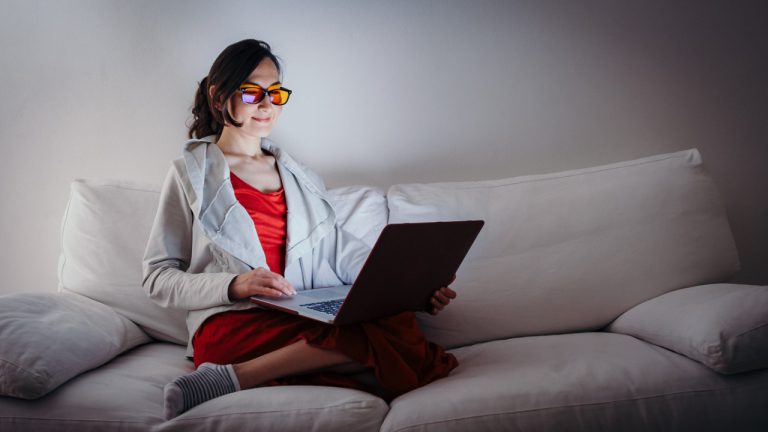According to the American Optometric Association (AOA), the average American worker spends seven hours a day staring at screens. It’s no wonder so many people are curious about the benefits of blue light glasses.
Yet a recent study indicates blue light glasses are not an effective tool for preventing eye strain.
The Background on Blue Light
Sunlight emits all colors of the rainbow in a combination that displays to people as white. Light that appears bright white to the human eye has a greater blue component.
Digital screens, such as cell phones, tablets, computers and laptops, emit smaller amounts of blue light. Because blue light is bright, some evidence suggests looking at blue light shortly before bedtime can interrupt natural circadian rhythms, making it harder to get a good night’s sleep.
In general, exposure to light is necessary for overall health, and blue light is not dangerous.
Blue light blocking glasses (with or without a prescription) use a lens filter to block blue light emitted by digital screens. Some blue light glasses block up to 100% of blue light, while others block only a portion. The supposed benefit of these glasses is to minimize discomfort from blue light and glare. The AOA suggests their use by people with computer vision syndrome, eye strain associated with long-term use of digital devices and exposure to LED and fluorescent lighting.
What’s the Deal with Digital Eye Strain?
Digital eye strain, also called computer vision syndrome, is a condition caused by excessive screen viewing and can cause:
- Blurred vision
- Dry eyes
- Eye strain
- Headaches
- Neck and shoulder pain
These symptoms are uncomfortable, but they’re often temporary. Protecting your vision before and after these symptoms occur is usually enough to start feeling better. There’s little evidence to show exposure to blue light from digital devices causes permanent eye damage. However, there’s no harm to your eyes if you do choose to wear blue light glasses.
To Prevent Eye Strain, Skip the Blue Light Glasses
Even without blue light glasses, you can do several things to protect your eyes from digital eye strain.
- The “20-20-20 Rule” gives your eyes a break. Every 20 minutes look at an object 20 feet away for at least 20 seconds.
- Artificial tears help prevent dry eyes throughout the day.
- Sit about 25 inches or an arm’s length away from your computer or laptop screen.
- Use screen filters on your devices or computer to reduce glare and lessen eye strain.
- Visit an optometrist if vision issues don’t improve or you’re experiencing serious discomfort.
Talk to a Professional
Get expert ophthalmology care from the eye care professionals at St. Elizabeth.

